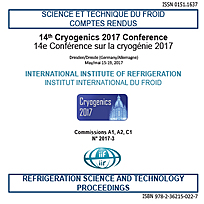
Document IIF
Analyse des systèmes de reliquéfaction de gaz d’évaporation basés sur un cycle en cascade et un cycle de Brayton inversé pour évaluer la pertinence de leur utilisation sur les méthaniers équipés de moteurs à double combustible.
Analysis of cascade cycle and reverse Brayton cycle based bog reliquefaction systems for their suitability in LNG carrier ships with dual fuel engines.
Numéro : pap. n. 0090
Auteurs : KOCHUNNI S. K., CHOWDHURY K.
Résumé
Liquefied Natural Gas (LNG) carrier ships with dual fuel engines use natural gas often by pumping and vaporizing LNG. The cold energy of LNG can be utilized to improve the performance of the reliquefaction system. Cascade cycle (using hydrocarbon or derivatives) and Reverse Brayton cycle (RBC) (using nitrogen) are compared for their suitability as reliquefaction systems using exergy analysis. To condense an equal quantity of boil-off gas (BOG), heat exchangers and exergy input required for RBC are higher. RBC performs better when cold is utilized by BOG stream rather than by N2 stream. For cascade system, LNG cold cannot be extracted gainfully if flow rate of LNG through the pump is very low. One may apply the results given in this paper to choose either RBC or cascade cycles for reliquefaction of BOG utilizing cold from LNG fuel to engine and meet the criteria of size, power consumption and safety.
Documents disponibles
Format PDF
Pages : 7 p.
Disponible
Prix public
20 €
Prix membre*
Gratuit
* meilleur tarif applicable selon le type d'adhésion (voir le détail des avantages des adhésions individuelles et collectives)
Détails
- Titre original : Analysis of cascade cycle and reverse Brayton cycle based bog reliquefaction systems for their suitability in LNG carrier ships with dual fuel engines.
- Identifiant de la fiche : 30021743
- Langues : Anglais
- Source : Cryogenics 2017. Proceedings of the 14th IIR International Conference: Dresden, Germany, Mai 15-19, 2017.
- Date d'édition : 15/05/2017
- DOI : http://dx.doi.org/10.18462/iir.cryo.2017.0090
Liens
Voir d'autres communications du même compte rendu (71)
Voir le compte rendu de la conférence
Indexation
- Thèmes : GNL et GPL
- Mots-clés : Carburant; Comparaison; Méthanier; Liquéfaction; Brayton; Simulation; Système en cascade; GNL; Cycle thermodynamique
-
REVIEW OF NATURAL GAS LIQUEFACTION CYCLES AND S...
- Auteurs : LINNETT D. T.
- Date : 1983
- Langues : Anglais
Voir la fiche
-
Utilization of engine exhaust gas in boil-off g...
- Auteurs : KOCHUNNI S. K., CHOWDHURY K.
- Date : 08/05/2019
- Langues : Anglais
- Source : Cryogenics 2019. Proceedings of the 15th IIR International Conference: Prague, Czech Republic, April 8-11, 2019.
- Formats : PDF
Voir la fiche
-
L'ANALYSE THERMODYNAMIQUE D'EXPLOITATION DE LA ...
- Auteurs : CHRZ V., DURRER M., MIKULEC J.
- Date : 07/08/1983
- Langues : Français
- Source : [Refrigeration serving humanity]. Proceedings of the XVIth international Congress of Refrigeration.
- Formats : PDF
Voir la fiche
-
LNG power recovery.
- Auteurs : WONG W.
- Date : 1994
- Langues : Anglais
Voir la fiche
-
Evaluation and selection of the precooling stag...
- Auteurs : CASTILLO L., DORAO C. A.
- Date : 21/08/2011
- Langues : Anglais
- Source : Proceedings of the 23rd IIR International Congress of Refrigeration: Prague, Czech Republic, August 21-26, 2011. Overarching theme: Refrigeration for Sustainable Development.
- Formats : PDF
Voir la fiche
